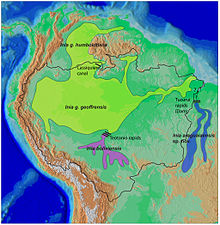The Araguaian river dolphin or Araguaian boto (Inia araguaiaensis) is a South American river dolphin population whose identification as a species was announced in 2014. It is native to the Araguaia-Tocantins basin of Brazil.
Discovery
The recognition of I. araguaiaensis as a separate species was announced on January 22, 2014. It was distinguished from other members of Inia on the basis of nuclear microsatellite and mitochondrial DNA data as well as differences in skull morphology (they generally have wider skulls). It also differs from the Amazon and Bolivian river dolphins in the number of teeth per hemimandible (24–28 versus 25–29 and 31–35, respectively). It is the first new river dolphin species to be described since 1918.
Description
Members of the genus are gray to pink in color and have a body length range from 1.53 to 2.6 m (5.0 to 8.5 ft). They have a dorsal ridge rather than a fin. Their neck vertebrae are unfused, allowing them to turn their heads sharply. Like other river dolphins, I. araguaiaensis has a prominent forehead and a much longer snout than those of most marine dolphins, as well as smaller eyes than marine dolphins. Because their aquatic environment is often turbid, their vision is not as well developed. River dolphins tend to be less active than marine dolphins. They feed mainly on fish, aided by echolocation.
The estimated times of divergence with I. boliviensis, P. blainvillei and L. vexillifer are 2.9, 12.0 and 16.2 Ma ago, respectively.
Discovery
The recognition of I. araguaiaensis as a separate species was announced on January 22, 2014. It was distinguished from other members of Inia on the basis of nuclear microsatellite and mitochondrial DNA data as well as differences in skull morphology (they generally have wider skulls). It also differs from the Amazon and Bolivian river dolphins in the number of teeth per hemimandible (24–28 versus 25–29 and 31–35, respectively). It is the first new river dolphin species to be described since 1918.
Description
Members of the genus are gray to pink in color and have a body length range from 1.53 to 2.6 m (5.0 to 8.5 ft). They have a dorsal ridge rather than a fin. Their neck vertebrae are unfused, allowing them to turn their heads sharply. Like other river dolphins, I. araguaiaensis has a prominent forehead and a much longer snout than those of most marine dolphins, as well as smaller eyes than marine dolphins. Because their aquatic environment is often turbid, their vision is not as well developed. River dolphins tend to be less active than marine dolphins. They feed mainly on fish, aided by echolocation.
Taxonomy
This species is most closely related to the Amazon river dolphin (Inia geoffrensis), from which it is believed to have split about 2.08 million years (Ma) ago, on the basis of mitochondrial DNA sequence comparisons. The time of divergence corresponds to the time the Amazon and Araguaia-Tocantins river basins became separated, implying vicariant speciation. Major rapids in the lower Tocantins River (into which the Araguaia River flows) are thought to have contributed to isolating the two species, as the Pará River (into which the Tocantins flows) connects with the Amazon River.
| non-South Asian river dolphins |
| |||||||||||||||||||||||||||||||||
The estimated times of divergence with I. boliviensis, P. blainvillei and L. vexillifer are 2.9, 12.0 and 16.2 Ma ago, respectively.
Conservation issues
The total population of the species is estimated to be of the order of 600 to 1500 individuals, and genetic diversity is limited. The ecology of its habitat has been adversely affected by agricultural, ranching and industrial activities, as well as by the use of dams for hydroelectric power. The inhabited section of the Araguaia River probably extends over about 1500 km out of a total length of 2110 km. The Tocantins River habitat is fragmented by six hydroelectric dams, so the population there is at particular risk. The authors of the discovery paper regard its probable eventual IUCN status to be Vulnerable or worse.| Scientific classification | |
|---|---|
| Kingdom: | Animalia |
| Phylum: | Chordata |
| Class: | Mammalia |
| Subclass: | Eutheria |
| Order: | Cetacea |
| Suborder: | Odontoceti |
| Superfamily: | Inioidea |
| Family: | Iniidae |
| Genus: | Inia |
| Species: | I. araguaiaensis |
| Binomial name | |
| Inia araguaiaensis Hrbek et al., 2014 | |
 | |
| Inia spp. ranges. I. araguaiaensis is in blue at right; I. geoffrensis and I. boliviensis are light green and purple, respectively. | |

This work is licensed under a Creative Commons Attribution-ShareAlike 3.0 Unported License.




 04:28
04:28
 Planet Worldwide
Planet Worldwide



 Posted in:
Posted in:
0 comments:
Post a Comment